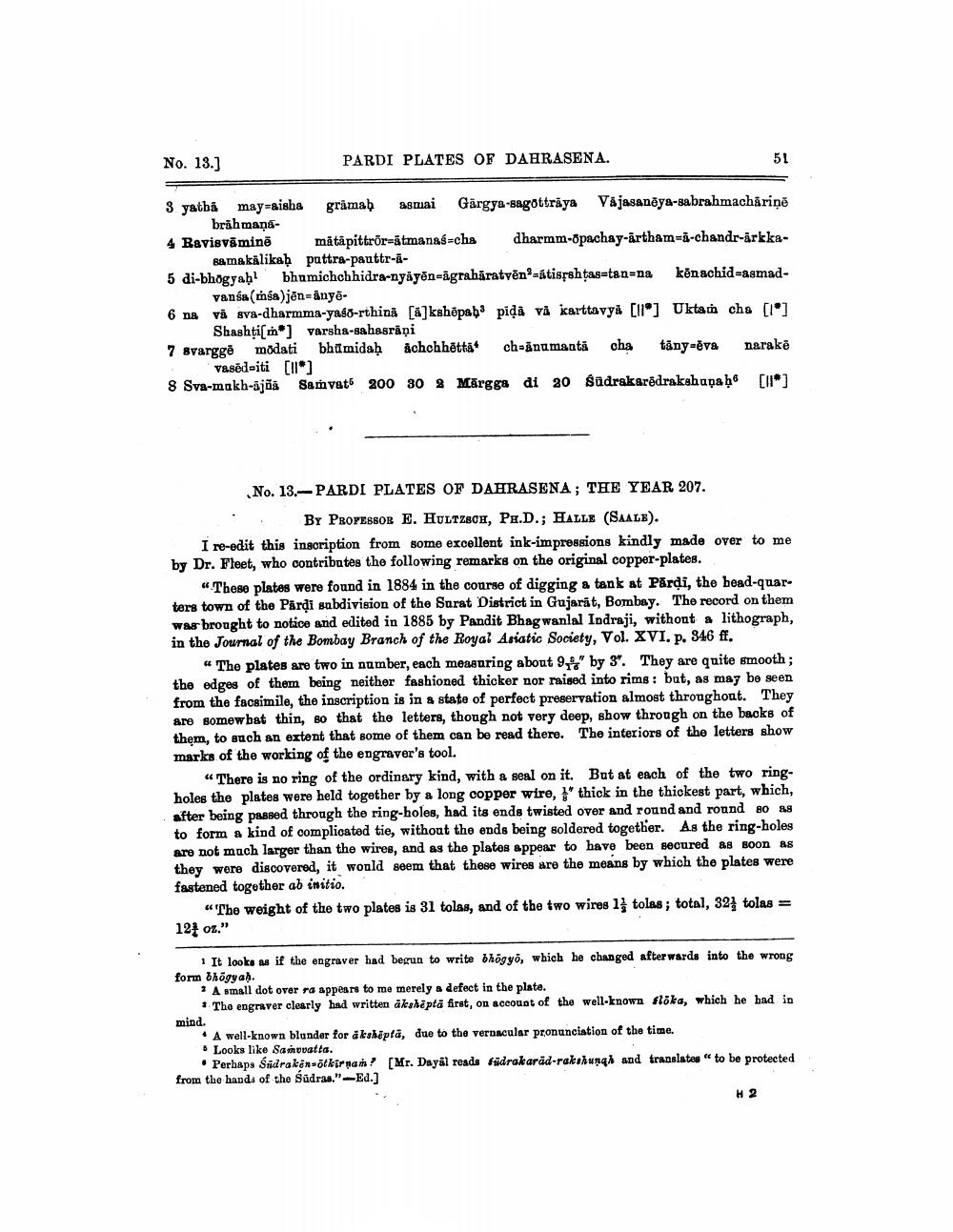________________
No. 13.]
PARDI PLATES OF DAHRASENA.
3 yatba may-aisha gramab asmai Gärgya-sagottraya Vájasan ya-sabrahmachariņi
brahman - 4 Ravisvāminē mātăpittror=ātmanaś=cha dharmm-opachay-artham=i-chandr-arkka
Bamakälikaḥ pattra-pauttr-a5 di-bhogyah bhumichchhidra-nyäyən-ägrahāratvēn-átisșshtag=tan=na konachid=asmad
vansa (msa)jēn=anyē. 6 navā sva-dharmma-yaso-rthina [X]kshēpas pidä và karttavyå [ll"] Uktań cha [*]
Shashti[m] varsha-sahasrāņi 7 svarggē modati bhūmidaḥ achchhēttä* ch-anumanta cha tany-ěva narakē
Vasēdeiti [11] 8 Sva-makh-ājõa Samvat 200 30 % Mārgga di 20 sadrakarēdrakshapaho [ll]
No. 13.-PARDI PLATES OF DAHRASENA; THE YEAR 207.
BY PROFESSOR E. HULTZ80I, PA.D.; HALLE (SAALE). I re-edit this inscription from some excellent ink-impressions kindly made over to me by Dr. Fleet, who contributes the following remarks on the original copper-plates.
« These plates were found in 1884 in the course of digging a tank at Pārdi, the head-quarters town of the Părţi subdivision of the Surat District in Gujarat, Bombay. The record on them was brought to notice and edited in 1885 by Pandit Bhagwanlal Indraji, without a lithograph, in the Journal of the Bombay Branch of the Royal Asiatic Society, Vol. XVI. p. 346 ff.
# The plates are two in number, each measuring about 94" by 3". They are quite smooth; the edges of them being neither fashioned thicker nor raised into rims: but, as may be seen from the facsimile, the inscription is in a state of perfect preservation almost throughout. They are somewbat thin, so that the letters, though not very deep, show through on the backs of them, to such an extent that some of them can be read there. The interiors of the letters show marks of the working of the engraver's tool.
“There is no ring of the ordinary kind, with a seal on it. But at each of the two ringholes the plates were held together by a long copper wire, thick in the thickest part, which, after being passed through the ring-holes, had its ends twisted over and round and round 80 49 to form a kind of complicated tie, without the ends being soldered together. As the ring-holes are not much larger than the wires, and as the plates appear to have been secured as soon as they were discovered, it would seem that these wires are the means by which the plates were fastened together ab initio
"The weight of the two plates is 31 tolas, and of the two wires 1 tolas; total, 321 tolas = 127 oz."
It looks as if the engraver had begun to write bhögyö, which he changed afterwards into the wrong form thögyaḥ.
? A small dot over ra appears to me merely a defect in the plate.
• The engraver clearly had written akshēpta first, on account of the well-known flöka, which he had in mind.
• A well-known blunder for å kshēptă, due to the vernacular pronunciation of the time. . Looks like Samuvatta.
• Perhaps Sidrakensõtkirra? (Mr. Dayal reads Fridrakarad-rakshn and translates to be protected from the hands of the Sūdras." -Ed.)
H 2




